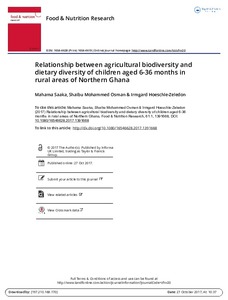| dc.contributor.author | Saaka, M. |
| dc.contributor.author | Osman, S.M. |
| dc.contributor.author | Hoeschle-Zeledon, Irmgard |
| dc.date.accessioned | 2019-12-04T11:10:59Z |
| dc.date.available | 2019-12-04T11:10:59Z |
| dc.date.issued | 2017 |
| dc.identifier.citation | Saaka, M., Osman, S.M. & Hoeschle-Zeledon, I. (2017). Relationship between agricultural biodiversity and dietary diversity of children aged 6-36 months in rural areas of Northern Ghana. Food & Nutrition Research, 61(1), 1-10. |
| dc.identifier.issn | 1654-6628 |
| dc.identifier.uri | https://hdl.handle.net/20.500.12478/2321 |
| dc.description | Open Access Article; Published online: 27 Oct 2017 |
| dc.description.abstract | In this study, we investigated the relationship between agricultural biodiversity and dietary diversity of children and whether factors such as economic access may affect this relationship.
This paper is based on data collected in a baseline cross-sectional survey in November 2013.The study population comprising 1200 mother-child pairs was selected using a two-stage cluster sampling. Dietary diversity was defined as the number of food groups consumed 24 h prior to the assessment. The number of crop and livestock species produced on a farm was used as the measure of production diversity. Hierarchical regression analysis was used to identify predictors and test for interactions.
Whereas the average production diversity score was 4.7 ± 1.6, only 42.4% of households consumed at least four food groups out of seven over the preceding 24-h recall period. Agricultural biodiversity (i.e. variety of animals kept and food groups produced) associated positively with dietary diversity of children aged 6–36 months but the relationship was moderated by household socioeconomic status. The interaction term was also statistically significant [β = −0.08 (95% CI: −0.05, −0.01, p = 0.001)].
Spearman correlation (rho) analysis showed that agricultural biodiversity was positively associated with individual dietary diversity of the child more among children of low socioeconomic status in rural households compared to children of high socioeconomic status (r = 0.93, p < 0.001 versus r = 0.08, p = 0.007). Socioeconomic status of the household also partially mediated the link between agricultural biodiversity and dietary diversity of a child’s diet.
The effect of increased agricultural biodiversity on dietary diversity was significantly higher in households of lower socioeconomic status. Therefore, improvement of agricultural biodiversity could be one of the best approaches for ensuring diverse diets especially for households of lower socioeconomic status in rural areas of Northern Ghana. |
| dc.description.sponsorship | United States Agency for International Development |
| dc.format.extent | 1-10 |
| dc.language.iso | en |
| dc.subject | Biodiversity |
| dc.subject | Dietary |
| dc.subject | Households |
| dc.subject | Agrobiodiversity |
| dc.subject | Preschool Children |
| dc.subject | Socioeconomic Status |
| dc.subject | Causal Mediation |
| dc.subject | Interaction |
| dc.subject | Northern Ghana |
| dc.title | Relationship between agricultural biodiversity and dietary diversity of children aged 6-36 months in rural areas of Northern Ghana |
| dc.type | Journal Article |
| dc.description.version | Peer Review |
| cg.contributor.crp | Integrated Systems for the Humid Tropics |
| cg.contributor.affiliation | University for Development Studies, Ghana |
| cg.contributor.affiliation | International Institute of Tropical Agriculture |
| cg.coverage.region | Africa |
| cg.coverage.region | West Africa |
| cg.coverage.country | Ghana |
| cg.isijournal | ISI Journal |
| cg.authorship.types | CGIAR and developing country institute |
| cg.iitasubject | Biodiversity |
| cg.iitasubject | Socioeconomy |
| cg.journal | Food & Nutrition Research |
| cg.howpublished | Formally Published |
| cg.accessibilitystatus | Open Access |
| local.dspaceid | 92021 |
| cg.targetaudience | Scientists |
| cg.identifier.doi | http://dx.doi.org/10.1080/16546628.2017.1391668 |

